Alpine Garden
Article written for
Calgary Horticultural Society for April 2009
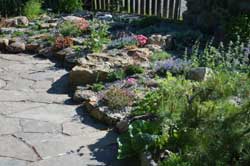 It is said that all passionate gardeners eventually become rock gardeners. For those gardeners with limited space or who run out of room for new plants (and who doesn’t), the rock garden is the ideal solution. What is a rock garden? A broad definition is: A rock garden is composed of plants that look good growing among rocks. Such plants may be at the seashore, in the forest, in the desert, in the tundra and of course the mountains.
It is said that all passionate gardeners eventually become rock gardeners. For those gardeners with limited space or who run out of room for new plants (and who doesn’t), the rock garden is the ideal solution. What is a rock garden? A broad definition is: A rock garden is composed of plants that look good growing among rocks. Such plants may be at the seashore, in the forest, in the desert, in the tundra and of course the mountains.
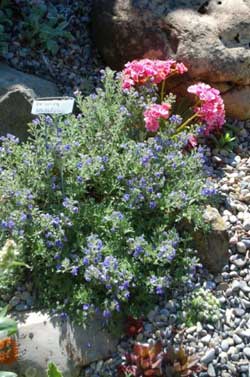 My garden here in Black Diamond, is an Alpine Rockery and contains plants that you would find growing among rocks in the mountains. An alpine plant, strictly defied, is a plant that is native too mountain heights above the timberline in sub-alpine and alpine zones. The original word “alpine” is connected with the Alps, the grand mountain range that extends from France into Switzerland and Italy. Every continent in the world has Alpine regions and plants from above the timberline in these other regions are also known as Alpines. Casual usage has led the word “alpine” to be interchanged with “rock garden plant” thus many rock garden plants are not alpines. However because plants from the alpine regions grow low with a cushion habit and in miniaturized proportions, they can be confused with classic rock garden plants. Furthermore, a large number of plants that grow below the tree line
My garden here in Black Diamond, is an Alpine Rockery and contains plants that you would find growing among rocks in the mountains. An alpine plant, strictly defied, is a plant that is native too mountain heights above the timberline in sub-alpine and alpine zones. The original word “alpine” is connected with the Alps, the grand mountain range that extends from France into Switzerland and Italy. Every continent in the world has Alpine regions and plants from above the timberline in these other regions are also known as Alpines. Casual usage has led the word “alpine” to be interchanged with “rock garden plant” thus many rock garden plants are not alpines. However because plants from the alpine regions grow low with a cushion habit and in miniaturized proportions, they can be confused with classic rock garden plants. Furthermore, a large number of plants that grow below the tree line 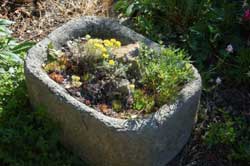 are just as attractive and as suitable for growing in an alpine or rock garden as the true alpines; even though some can be fairly tall it is generally accepted that to be classed as an alpine, the plant should be no taller that 10 inches. This allows you to be able to fit hundreds of plants into a space that would fit only a dozen traditional perennials. (Are you confused yet)?
are just as attractive and as suitable for growing in an alpine or rock garden as the true alpines; even though some can be fairly tall it is generally accepted that to be classed as an alpine, the plant should be no taller that 10 inches. This allows you to be able to fit hundreds of plants into a space that would fit only a dozen traditional perennials. (Are you confused yet)?
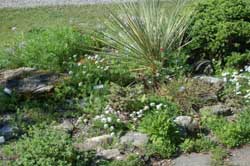 When giving tours of the rockery I often have to explain what make a classic alpine garden, and how each plant is placed to make the most of the overall effect, in the garden. When alpine plants bloom each flower is relative large compared to the diminutive over all size of the plant. Some say this is so they attract pollinating insects. This seems a good explanation as at the higher elevations perhaps bees are few and far between. Alpine plants tend to bloom in early spring, June, in the Alberta foothills. Perhaps this is to allow the seed enough time to mature and become ready for the spring season, thus avoiding early damaging frosts and wetting snowstorms.
When giving tours of the rockery I often have to explain what make a classic alpine garden, and how each plant is placed to make the most of the overall effect, in the garden. When alpine plants bloom each flower is relative large compared to the diminutive over all size of the plant. Some say this is so they attract pollinating insects. This seems a good explanation as at the higher elevations perhaps bees are few and far between. Alpine plants tend to bloom in early spring, June, in the Alberta foothills. Perhaps this is to allow the seed enough time to mature and become ready for the spring season, thus avoiding early damaging frosts and wetting snowstorms.
Many true alpine plants are surprisingly easy to cultivate in the rockery and so you may have to spend time each spring and summer keeping 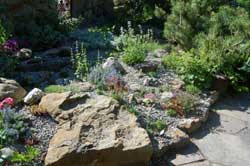 the more aggressive plants in check. Rock Garden Plants may appear to be dainty and delicate but they have adapted to withstand poor, rocky soil, extremes of weather, including high winds, deep snow and summer drought. Their environment has shaped their size and habit this makes these plants perfect for gardens in the Southern Alberta area.
the more aggressive plants in check. Rock Garden Plants may appear to be dainty and delicate but they have adapted to withstand poor, rocky soil, extremes of weather, including high winds, deep snow and summer drought. Their environment has shaped their size and habit this makes these plants perfect for gardens in the Southern Alberta area.
Over the years I have tried so many alpine plants. Some with amazing success, such as Scabiosa Japonica Var. alpina “Ritz Blue” Startling cushion like flowers sit above compact course texture leaves. Saxifraga arendsii “Floral Carpet”,and Saxifraga canis dalmatica are two of the most wonderful Saxifraga’s that I find grows well in SouthernAlberta. Adonis vernalis is worth every penny with is large bight yellow flowers that 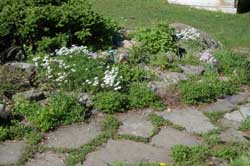 appear so earlyin the spring. Acinos alpinus covers the Reader Rock Garden in Calgary and will knock your socks off. Potentilla neumanii verna nana is a little creeping rock garden plant that loves the heat. For a shady bed try Primula alpicola v. violacea or Hepatica nobilis both have beautiful purple flowers. Or even some Heuchera pulchella an Alberta wildflower. Half the fun of the Alpine Garden is the collecting and sharing of plants, once you start you will need to fill every crack and craves in your Alpine Garden area.
appear so earlyin the spring. Acinos alpinus covers the Reader Rock Garden in Calgary and will knock your socks off. Potentilla neumanii verna nana is a little creeping rock garden plant that loves the heat. For a shady bed try Primula alpicola v. violacea or Hepatica nobilis both have beautiful purple flowers. Or even some Heuchera pulchella an Alberta wildflower. Half the fun of the Alpine Garden is the collecting and sharing of plants, once you start you will need to fill every crack and craves in your Alpine Garden area.
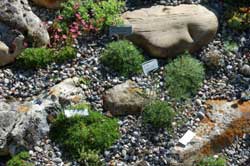 |
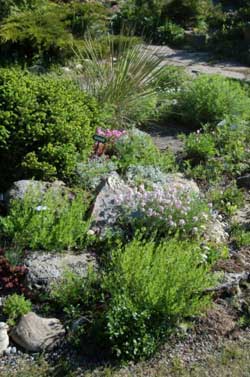 |
 |
